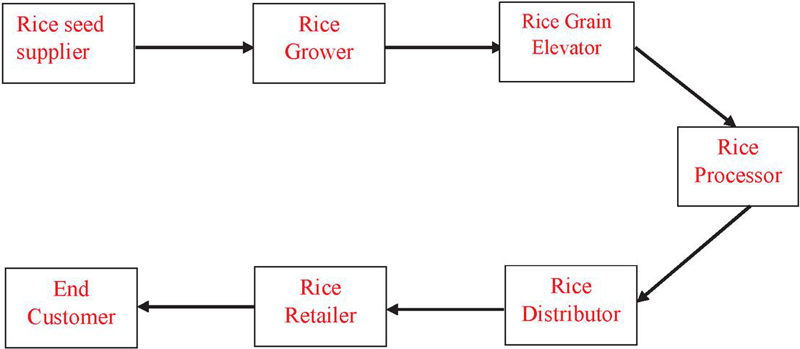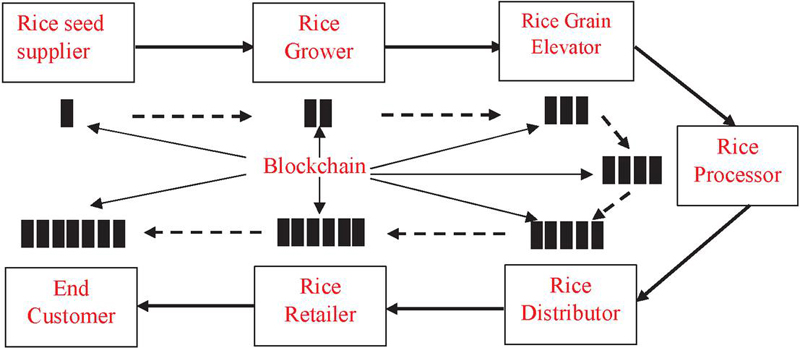Blockchain Technology Enabled Traceability Framework: Food Supply Chain Perspective
Dnyaneshwar J. Ghode1, Aniruddha A. Wagire2, Pravin A. Dwaramwar3 and Rajesh H. Khobragade3
1Government Polytechnic, Sakoli, India
2Government Polytechnic, Awasari, India
3Shri Ramdeobaba College of Engineering and Management, Nagpur, India
E-mail: djghode@gmail.com; awagire@yahoo.com; dwaramwarpa@rknec.edu; khobragaderh@rknec.edu
*Corresponding Author
Received 07 September 2023; Accepted 16 October 2023; Publication 21 November 2023
Abstract
In the global market, consumers have expectations of good quality food products. To provide flawless food products, traceability has become dominant in a complex food supply chain (SC) network. Stakeholders of the food SC hesitate to share their data with each other, as they have different business strategies. Blockchain Technology (BCT) brings all the parties of food SC on single platform to improve interorganizational trust. The implementation of BCT in food SC offers the traceability of products. This paper proposes a framework for traceability of products in food SC using BCT that offers the consumers to trace the origin of the food products. Blockchain enhances the food traceability, minimize the data tampering, and improves data transparency in food SC. BCT enabled food SC framework has been tested using case study of rice SC and found the enhancement in traceability.
Keywords: Blockchain technology, traceability, food supply chain, framework.
1 Introduction
Blockchain technology (BCT) is enormously budding technology in today’s scenario of industry 4.0 [1]. The foremost application of BCT is bitcoin [2]. Mostly the BCT is applied in finance sector and recently the research is going on to apply it in supply chain (SC) [3, 4]. BCT is one the most influencing technology to the SC, as it has potential to develop trust among the various SC partners by providing transparency, traceability, and security [5, 6]. Food SC systems are intricate systems suffers with the issues of counterfeit and scandals that can be overcome using the disruptive technologies like BCT to provide a safety and quality food to the consumers [7]. SC should be such that the product can be traceable by the consumers. There are very few systems that provides the secured tracking of the product. BCT can provide origin of the product. However, there are many frameworks that results into an efficient food SC.
The goal of the present study is to propose a framework that offers a traceability of products in food SC. A framework of BCT based food SC is responsible for traceability of food that prevents the fraud in food products. Real time tracking of the information of food products in food SC done using BCT to enhance the trust of the end user.
Remainder of this article is systematized as follows. Literature review on fundamental of blockchain and BCT enabled food SC is provided in Section 2. Framework of traceability of food SC using blockchain is proposed in Section 3. Section 4 concludes this study.
2 Literature Review
The aim of this study is to develop a framework of BCT for the traceability of food SC. The focus of the literature review is to answer following research question:
• How does the BCT influence the traceability in food SC performance?
2.1 Fundamentals of Blockchain
Satoshi Nakamoto introduced blockchain to the world in 2008. A peer-to-peer network has been implemented in bitcoin by him [2]. In blockchain, transaction data is documented and added in a sequential manner and stored in a distributed database to produce eternal and immutable records [9]. BCT is digitized distributed database consists of block in which data is recorded continuously. Figure 1 represented a structure of blockchain. For each transaction a new block is created. Blocks are appended in series with each other in chronological order. Once the transaction is recorded in block and appended in blockchain, it cannot be altered. Various governance rules are used to verify the transaction recorded in blocks [10].
The data transparency is the characteristics of the blockchain, as the data in blockchain is accessible to each member in blockchain. Hence, inter organizational trust is achieved among all the nodes. Also, the tampering of the data, saving in time and money can be achieved, as there is no role of third-party during transaction [11].
Figure 1 Representation of blockchain.
2.2 BCT in Food SC
Food SC consists of many distributed stakeholders. In food industry, effective and competent food SC is needed to cope up with restrictions of shelf-life of food [12]. The problem is that consumers who purchase the product, does not have knowledge about the origin of the product. The aim is to provide safe and genuine food to the consumers. BCT has a characteristic to trace the origin of the product so that it can provide food security, food safety, food integrity [13].
Table 1 Benefits of BCT based SC (Source: Dutta, et al., 2020)
| Benefits | Details |
| Data management | Matching of data of all the SC nodes. Secured storage of data. Real-time recoding of the data. |
| Transparency | Data is visible to all the stakeholders. Tracking of the products can be done in SC. Analysis of information can be done automatically. |
| Improves response time | Real-time data is available to all the parties of the SC enhance the response time. |
| Smart contract management | Smart contract inculcates the smart capabilities to automate the functions in the SC. Eliminates the need of third party. |
| Operational efficiency | SC operations can be done within optimum time. The SC system can become robust by addressing the issues on time. |
| Disintermediation | Helps for continuous process of transactions in SC. Increases speed Improvement in the inter organizational trust. |
| Immutability | All the transactions are verified using consensus mechanism. No one can tamper the data in SC. |
Some of the applications of BCT are seen in the retail companies like Walmart, where BCT is used for maintaining safety of food in the SC. Also, BCT eliminate the involvement of third party to provide transparency in food supply [14]. Some of the benefits of the BCT based SC are showing in Table 1.
Some related frameworks have been studied as follows:
• Chang, et al., offered a theoretical framework to offer traceability of product [15].
• Wu et al., introduced a framework to trace online products [16].
• Malik et al., suggested that origin of food can be traced using BCT [17].
• Kumar et al., offered a framework to track a product for social and economic sustainability [18].
After studying the related work, there is need to improve the traceability of products in food SC. Hence, this study focus on the development of BCT based food SC.
3 Framework of BCT Based Food SC
The main objective of present study is to propose a framework of BCT based food SC, to make food industry and its SC standardize with respect to traceability, visibility, and provenance. Blockchain is embedded in the existing system of a particular food SC wherein its members act as nodes communicating with each other through consensus.
Information among all the nodes is shared, distributed, and decentralized while maintaining security throughout the SC. To deal with real time tracking of food products in SC, the BCT enabled framework is proposed as shown in Figure 2.
Figure 2 Framework of real time traceability of food.
In this framework, using BCT, consumers can recognize the source of food products and its constituents, typically after food products are found to be flawed. A BCT enabled food SC traceability system permits a business to file and to trace a food product via various phases and processes involved in the manufacturing, operations, dispersal, and handling of products from initial stage of making to final stage of consumption. Blockchain stores information of food at each stage from source of raw material to consumer that provides the origin of food products in food SC [19]. As blockchain enhances the transparency, it facilitates to detect the root of defects of a food product. Identified unsafe products can be prevented to reach to the consumers by recalling such food products.
In external BCT enabled food SC traceability system, all food products are to be individually recognized, and data to be published among all the food SC stakeholders. As all the data is stored in blocks in encrypted form and distributed among all the nodes in food SC, it is not possible to hack and tamper the data in the BCT enabled food SC [20]. The authentication of traceable food items can be done by using a unique code and its batch id. Once the food product is traced externally, its inimitable code is communicated to all the parties of the SC. In this way, the food item can be linked with the data needed for tracing. External traceability system provides the traceability of food product at supplier’s end as well as at consumer’s end.
In internal BCT enabled food SC traceability system, the food products are identified from initial raw stage to final product stage. After the assembly or processing or reshaping or repacking, a latest food product must have separate inimitable product code. This latest food product is linked with the all its constituent using BCT in its internal SC so that traceability of that food product can be maintained.
4 Rice SC Case Study
The objective of this research is to find the effect of BCT on food SC traceability. Hence, according to Yin (2009) case study has been chosen in this work [21]. Food SC encompasses the flow of food product and information from upstream i.e. farmer to downstream i.e. consumers. However, there is no rule to identify food product for case study [22]. Accordingly, in this study, Rice food grown in the area of Bhandata district, India has been selected for testing BCT enable food SC traceability framework.
Rice is being grown and milled in the area of Bhandara district, India. SC of rice is shown in Figure 3 indicates the product movements in the rice SC, showing the participants as per their situation in the SC. The rice is supplied from farmer to rice processor. Afterword supplies to the consumers through distributor and retailer in various packages.
Figure 3 Rice supply chain.
In the current SC quality of rice can be compromised due to possibility of adulteration at various stages of SC. Most of the customer demands the good quality of rice and requests the information includes name of breed of rice seeds, fertilizers used, harvesting weather, quantity of rice, rice processing conditions, date of processing and packaging, and distributors and retailer’s data. The authenticity of the information of rice SC also needed by the end consumers. This encourages to improve the traceability in food SC using BCT [23]. Hence, BCT has implemented in the rice SC, so that traceability of rice at each stage of SC can be enhanced.
Figure 4 Rice supply chain with BCT.
Framework of BCT enabled rice SC is shown in Figure 4 indicating all the stakeholders of rice SC have interconnected to each other using blockchain. The data of product quality as well as transaction of rice between the two parties has been recorded in the blocks at each stage of rice SC and then appended in the blockchain. As blockchain has a distributed database, all the transaction details of rice SC have been shared with all the members of the rice SC. Moreover, all the stakeholder has been able to trace the product at each stage of SC. To access the performance of BCT enable rice SC, feedback from all the stakeholders have been taken. As all members have been able to see the transactions happened among stakeholders, the response of all the members found satisfactory. Improvement in the traceability of the rice SC boosted the belief of the end consumers on the rice quality.
5 Implications
This study offers numerous implications to the practitioners considering BCT in food SC. The foremost implication is that in the era of industry 4.0, because of extraordinary characteristics BCT is in demand for the adoption in various SC in turn food SC. Practitioners those are hesitating to adopt BCT in food SC, can find this article useful. As food SC is a sensitive area to all the consumers, traceability plays important role in food SC to earn the trust of consumers on food products [24]. If any of the member of the food SC makes fraud by tempering data of transactions, BCT keeps the record of that transaction and publish it to all the members of the food SC so that defaulter party can be trace down [25].
In the competitive market, many companies aim to reduce the cost of their products. Transparency and traceability in transactions of the products in SC due to adoption of BCT lead to find the exact price of the product [19]. However, the framework epitomizes a tactical evaluation of BCT that can be utilized to improve the performance of SC. In this view, price of the rice at the all the stages of SC can be known to all the stakeholders. Hence, BCT helps to limit the exact margin in trade price to get the rice at optimum price to the end consumers. In addition, all the stakeholders including famers gets the upright price of the food products. Traceability in BCT enabled food SC supports to provide the data of the harvesting as well as processing of food with exact date.
The proposed framework of BCT enabled food SC can trace the food products in effective manner. Also, it assists in monitoring of the food delivery and confirms that all the members of food SC follows all the governing rules.
6 Conclusion and Future Scope
The purpose of this article is to propose a framework that provides the traceability of the product in the food SC network. Accordingly, the BCT enabled food SC has been presented. This framework caters traceability of products across food SC, real time tracking of the product, problem detection at source, efficient product recall, provenance, provide authenticity of the product in food SC, fraud and counterfeit detection in SC and offers transparency in food SC. The proposed framework of food SC with BCT has been tested by considering the rice SC. After the investigation with all the stakeholders of rice SC, it has been found that quality of rice can be maintained by reducing adulteration, price margin of the rice can be control by enhancing transparency, and end users can trace the rice right from harvesting. In this way, BCT helps to develop a food SC mechanism in which every manufacturer and distributor can recall faulty products that protects public from health problems. A recall is intended to remove adulterated or misbranded food products from commerce. This framework deals with the identification of food products using capabilities of blockchain in food SC.
BCT has an ability to change the perspective of traditional SC. In future, BCT can be implemented in various applications. The proposed framework of BCT enabled food SC could lead into many fascinating future research scope. Different firms have different products and different goals. Accordingly, scope of BCT applications will be can be varied as per firm’s strategies.
References
[1] Ghode, D. J., Yadav, V., Jain, R., and Soni, G. (2020). Blockchain adoption in the supply chain: an appraisal on challenges. Journal of Manufacturing Technology Management. https://doi.org/10.1108/JMTM-11-2019-0395.
[2] Nakamoto, S. (2009). Bitcoin: A Peer-to-Peer Electronic Cash System. 1–9. https://bitcoin.org/bitcoin.pdf.
[3] Nguyen, Q. K. (2016). Blockchain-A Financial Technology for Future Sustainable Development. Proceedings – 3rd International Conference on Green Technology and Sustainable Development, GTSD 2016, 51–54. https://doi.org/10.1109/GTSD.2016.22.
[4] Queiroz, M. M., Telles, R., and Bonilla, S. H. (2019). Blockchain and supply chain management integration: a systematic review of the literature. Supply Chain Management: An International Journal, 24(1), 62–84. https://doi.org/10.1108/SCM-03-2018-0143.
[5] Ghode, D., Yadav, V., Jain, R., and Soni, G. (2020). Adoption of blockchain in supply chain: an analysis of influencing factors. Journal of Enterprise Information Management, 33(3), 437–456. https://doi.org/10.1108/JEIM-07-2019-0186.
[6] Duan, J., Zhang, C., Gong, Y., Brown, S., and Li, Z. (2020). A content-analysis based literature review in blockchain adoption within food supply chain. International Journal of Environmental Research and Public Health, 17(5), 1–17. https://doi.org/10.3390/ijerph17051784.
[7] Vishal Gaur, and AbhinavGaiha. (2020). Building a Transparent Supply Chain. Harvard Business Review, 98(3), 94–103. https://hbr.org/2020/05/building-a-transparent-supply.
[8] Wamba, S. F., Robert, J., Kamdjoug, K., Bawack, R. E., Keogh, J. G., Fosso, S., Robert, J., Kamdjoug, K., and Bawack, R. E. (2019). Bitcoin, Blockchain and Fintech: a systematic review and case studies in the supply chain. Production Planning and Control, 0(0), 1–28. https://doi.org/10.1080/09537287.2019.1631460.
[9] Treiblmaier, H. (2018). The Impact of the Blockchain on the Supply Chain: A Theory-Based Research Framework and a Call for Action. Supply Chain Management: An International Journal, 23(6), 545–559. https://doi.org/10.1108/SCM-01-2018-0029.
[10] Wang, Y., Singgih, M., Wang, J., and Rit, M. (2019). Making sense of blockchain technology: How will it transform supply chains? International Journal of Production Economics, 211(February), 221–236. https://doi.org/10.1016/j.ijpe.2019.02.002.
[11] Ghode, D. J., Yadav, V., Jain, R., and Soni, G. (2020). Blockchain adoption in the supply chain: an appraisal on challenges. Journal of Manufacturing Technology Management. https://doi.org/10.1108/JMTM-11-2019-0395.
[12] Hua, J., Wang, X., Kang, M., Wang, H., and Wang, F. Y., 2018. Blockchain Based Provenance for Agricultural Products: A Distributed Platform with Duplicated and Shared Bookkeeping. IEEE Intelligent Vehicles Symposium, Proceedings, 2018-June(iv), 97–101.
[13] Kumar, A., Ghode, D. J., and Jain, R. (2022). An Adoption of Blockchain Technology in Agri Food Supply Chain: An Overview. Lecture Notes in Mechanical Engineering, 183–192. https://doi.org/10.1007/978-981-16-7059-6\_15.
[14] Polansek, T. (2019). Walmart creates Angus Beef Supply Chain, Cutting Out Meat Processors. Reuters. Accessed on 26th June 2022 https://www.reuters.com/article/us-walmart-beef/walmart-creates-angus-beef-supply-chain-cutting-out-meat-processors-idUSKCN1S021A.
[15] Chang, S. E., Chen, Y. C., and Lu, M. F. (2019). Supply chain re-engineering using blockchain technology: A case of smart contract based tracking process. Technological Forecasting and Social Change, 144(2019), 1–11. https://doi.org/10.1016/j.techfore.2019.03.015.
[16] Wu, H., Li, Z., King, B., Miled, Z. Ben, Wassick, J., and Tazelaar, J. (2017). A distributed ledger for supply chain physical distribution visibility. Information (Switzerland), 8(4), 1–18. https://doi.org/10.3390/info8040137.
[17] Malik, S., Kanhere, S. S., and Jurdak, R. (2018). ProductChain: Scalable blockchain framework to support provenance in supply chains. NCA 2018 – 2018 IEEE 17th International Symposium on Network Computing and Applications, 1–10. https://doi.org/10.1109/NCA.2018.8548322.
[18] Kumar, G., Saha, R., Buchanan, W. J., Geetha, G., Thomas, R., Rai, M. K., … Alazab, M. (2020). Decentralized accessibility of e-commerce products through blockchain technology. Sustainable Cities and Society, 62(March), 1–9. https://doi.org/10.1016/j.scs.2020.102361.
[19] Ghode, D. J., Jain, R., Soni, G., Singh, S. K., and Yadav, V. (2021). Architecture to Enhance Transparency in Supply Chain Management using Blockchain Technology. Procedia Manufacturing, 51(2019), 1614–1620. https://doi.org/10.1016/j.promfg.2020.10.225.
[20] Ghode, D. J., Yadav, V., Jain, R., and Soni, G. (2023). Exploring the integration of blockchain technology into supply chain: challenges and performance. Business Process Management Journal, 29(1), 223–239. https://doi.org/10.1108/BPMJ-09-2022-0421.
[21] Yin, R.K. 2009. “Case Study Research – Design and Methods.” Vol. 5. In Applied Social Research Methods Series. 4th ed.
[22] Kittipanya-ngam, P., and Tan, K. H. (2020). A framework for food supply chain digitalization: lessons from Thailand. Production Planning and Control, 31(2–3), 158–172. https://doi.org/10.1080/09537287.2019.1631462.
[23] Yakubu et al. (2022), PeerJ Computer Science, DOI: 10.7717/peerj- cs.801.
[24] Köhler, S., and Pizzol, M. (2020). Technology assessment of blockchain-based technologies in the food supply chain. Journal of Cleaner Production, 269(2020), 1–10. https://doi.org/10.1016/j.jclepro.2020.122193.
[25] Ghode, D. J., Yadav, V., Jain, R., and Soni, G. (2023). Exploring the integration of blockchain technology into supply chain: challenges and performance. Business Process Management Journal, 29(1), 223–239. https://doi.org/10.1108/BPMJ-09-2022-0421.
Biographies

Dnyaneshwar J. Ghode is a Lecturer in Mechanical Engineering Department at Government Polytechnic, Sakoli, Bhandara, Maharashtra, India. He completed his Master of Technology in Production and Industrial System Engineering from Indian Institute of Technology, Roorkee (India) and Ph.D. in Mechanical Engineering from Malviya National Institute of Technology, Jaipur (India). He has about 6.5 years of industrial and about 12 years of teaching experience. His research areas include, supply chain management, blockchain technology, industry 4.0, shop floor control system and quality management. He is a life member of ISTE. He is reviewer of various journals and conferences.

Aniruddha A. Wagire is a Lecturer in Automobile Engineering at Government Polytechnic, Awasari Khurd, Pune, Maharashtra. He has total 14 years of experience including teaching and industry. Before joining the Government Polytechnic, he was working with the company in the business of providing Customized Solutions in the Areas of Factory Planning, Project Engineering and Automation. He has earned his Bachelor’s Degree in Automobile Engineering and Master’s Degree in Mechanical Engineering (Design) from the Department of Mechanical Engineering, Rajarambapu Institute of Technology, Rajaramnagar, Shivaji University, Maharashtra, India. He has done his Ph.D. from the Malaviya National Institute of Technology Jaipur, Rajasthan, India. His doctoral studies topic was “Development of a Framework for Indian Manufacturing Industry Towards Adoption of Industry 4.0”. His consulting and teaching interests include Industry 4.0, Smart Manufacturing, Latent Semantic Analysis, Structural Equation Modelling, and Advance Manufacturing Technologies. He has authored various research articles in these areas at the international conferences and international journals like Production Planning and Control, Journal of Manufacturing Technology Management and International Journal of Business Excellence. He is a Life member of ISTE & a member of Society of Automotive Engineers and Production and Operations Management Society. He is Editorial board member of “Circular Economy – Frontiers in Sustainability”. He is also reviewer of various international journals and conferences.

Pravin A. Dwaramwar is working as an Associate Professor in Electronics & Computer Science Engineering at Shri Ramdeobaba College of Engineering and Management, Nagpur, India. He completed his B.Tech from VNIT, Nagpur in 1995 and Master of Technology in VLSI Design. He has about 28 years of teaching and professional experience. His research areas include RF Circuit Design, Signal Processing and Digital Design. He is a life member of ISTE.

Rajesh H. Khobragade is an Assistant Professor in Electronics Engineering at Shri Ramdeobaba College of Engineering and Management, Nagpur, Maharashtra, India. He has obtained Master of Technology in Digital Communication. He has about 22 years of teaching experience. His research area includes Analog and Digital circuits and system, HDL for design of digital circuits.
Journal of Graphic Era University, Vol. 12_1, 1–14.
doi: 10.13052/jgeu0975-1416.1211
© 2023 River Publishers







